Related Research Articles

The Tri-State Tornado was a deadly and destructive tornado that struck parts of three states in the Central United States on the afternoon of Wednesday, March 18, 1925. The most exceptional of at least 12 significant tornadoes produced by a major tornado outbreak that spanned a large portion of the Midwestern and Southern United States, the Tri-State Tornado killed at least 695 people, making it by far the deadliest tornado in United States history and the second-deadliest in world history. The 151-to-235-mile track left by the tornado, as it crossed from southeastern Missouri, through southern Illinois, and then into southwestern Indiana, is also the longest ever recorded.

The 1974 Super Outbreak was the second-largest tornado outbreak on record for a single 24-hour period, just behind the 2011 Super Outbreak. It was also the most violent tornado outbreak ever recorded, with 30 F4/F5 tornadoes confirmed. From April 3 to 4, 1974, there were 148 tornadoes confirmed in 13 U.S. states and the Canadian province of Ontario. In the United States, tornadoes struck Illinois, Indiana, Michigan, Ohio, Kentucky, Tennessee, Alabama, Mississippi, Georgia, North Carolina, Virginia, West Virginia, and New York. The outbreak caused roughly $843 million USD with more than $600 million in damage occurring in the United States. The outbreak extensively damaged approximately 900 sq mi (2,331 km2) along a total combined path length of 2,600 mi (4,184 km). At one point, as many as 15 separate tornadoes were on the ground simultaneously.

The 1985 United States – Canada tornado outbreak, referred to as the Barrie tornado outbreak in Canada, was a major tornado outbreak that occurred in Ohio, Pennsylvania, New York, and Ontario, on May 31, 1985. 44 tornadoes were counted including 14 in Ontario, Canada. It is the largest and most intense tornado outbreak ever to hit this region, and the worst tornado outbreak in Pennsylvania history in terms of deaths and destruction.
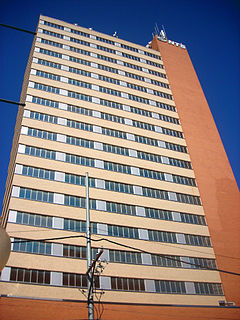
The Lubbock tornado was a tornado event that occurred in Lubbock, Texas, on Monday, May 11, 1970. It was one of the worst tornadoes in Texas history, and occurred exactly 17 years to the day after the deadly Waco Tornado. It is also the most recent F5 tornado to have struck a central business district of a large city.

The 1994 Palm Sunday tornado outbreak was the third notable US tornado outbreak to occur on Palm Sunday and the second to take place in the Southeastern United States. The outbreak produced 29 tornadoes from Texas to North Carolina, killing 40 people and injuring 491, and causing $140 million in damage. The deadliest storm of the outbreak, as well as in the US in 1994, was an F4 tornado that devastated Piedmont, Alabama. It struck the Goshen United Methodist Church right in the middle of the Palm Sunday service, collapsing the roof on the congregation and killing 20 people inside, including the Rev. Kelly Clem's 4-year-old daughter Hannah. Two other houses of worship were also destroyed mid-service. The supercell that formed this tornado tracked for 200 miles (322 km) to South Carolina.
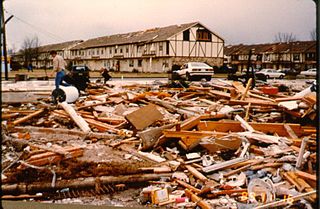
A destructive tornado outbreak struck a wide swath of the Southern and Eastern United States as well as Canada on November 15 and 16, 1989. It produced at least 40 tornadoes and caused 30 deaths as a result of two deadly tornadoes. The most devastating event was the Huntsville, Alabama F4 tornado, which killed 21 on the afternoon of November 15. Nine more fatalities occurred at a single elementary school by an F1 tornado on November 16 in Newburgh, New York, although further survey revealed that this might have been a downburst instead. This outbreak also produced the most tornadoes in a single day in New Jersey. Several other significant tornadoes were reported across 15 states.

This page documents notable tornadoes and tornado outbreaks worldwide in 2006. Strong and destructive tornadoes form most frequently in the United States, Bangladesh, and Eastern India, but they can occur almost anywhere under the right conditions. Tornadoes also develop occasionally in southern Canada during the Northern Hemisphere's summer and somewhat regularly at other times of the year across Europe, Asia, Argentina, Brazil and Australia. Tornadic events are often accompanied with other forms of severe weather, including strong thunderstorms, strong winds, and hail.
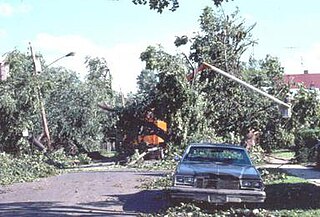
The 1989 Northeastern United States tornado outbreak was a series of tornadoes which caused more than $130 million in damage across the Northeastern United States on July 10, 1989. The storm system affected five states with severe weather, including hail up to 2.5 inches (6.4 cm) across, thunderstorm winds up to 90 mph (140 km/h), and 17 tornadoes. Several towns in New York and Connecticut were particularly hard-hit. Several homes were leveled in Schoharie, New York and extensive damage occurred in Bantam, Connecticut. A large section of Hamden, Connecticut, including an industrial park and hundreds of homes, was destroyed; and in some places buildings were flattened to the ground.

This page documents the tornadoes and tornado outbreaks that occurred in 2007, primarily in the United States. Most tornadoes form in the U.S., although some events may take place internationally, particularly in parts of neighboring southern Canada during the summer season. Some tornadoes also take place in Europe, e. g. in the United Kingdom or in Germany.
On the evening of Tuesday, August 7, 1979, at least three tornadoes touched down in southwestern Ontario, devastating scores of farms and homes in the Woodstock area. The southern end of that city suffered some of the most intense destruction along with several other nearby towns in Oxford County. Two people died, 142 were injured, and hundreds of homes suffered significant damage. Overall monetary losses totaled an approximate $100 million in 1979 Canadian dollars.

The Southern Ontario tornado outbreak of 2005 was a series of thunderstorms on the afternoon of August 19, 2005, that spawned tornadoes damaging homes in the Conestoga Lake, Fergus, and Tavistock areas. A tornado was reported within the Toronto city limits, although this was never officially confirmed by the Meteorological Service of Canada. The storms morphed into heavy rain cells when reaching Toronto. The Insurance Bureau of Canada has estimated that insured losses were the highest in the province's history, exceeding 500 million Canadian dollars, two and a half times that of Ontario's losses during the 1998 ice storm and the second largest loss event in Canadian history until another event of torrential rain of July 8, 2013.

In 2009, tornadic activity was generally near average. Each year, tornadoes and tornado outbreaks occur worldwide primarily under conductive conditions, though a majority of tornadoes form in the United States. Tornadoes also occur to a less frequent extent in Europe, Asia, and Australia. In the U.S., there were 1,304 reports of tornadoes received by the Storm Prediction Center (SPC), and 1,159 tornadoes were confirmed to have taken place. Worldwide, 45 fatalities were caused by tornadoes; 22 in the United States, 20 in India, eight in the Philippines, four in Canada, two in Greece and one each in Serbia and Russia.

The March 2009 tornado outbreak sequence was a series of tornado outbreaks which affected large portions of the Central, Southern, and Eastern United States from March 23 to March 29. A total of 56 tornadoes touched down during the event, two of which were rated as EF3.
The Southern Ontario Tornado Outbreak of 2009 was a series of severe thunderstorms that spawned numerous tornadoes in Southwestern Ontario, Central Ontario and the Greater Toronto Area (GTA) on August 20, 2009, and was the largest single-day tornado outbreak in Ontario history and the largest in Canadian history. During the afternoon and evening, 19 tornadoes touched down with four of them producing F2 damage. One F2 struck the town of Durham where significant damage occurred and one person was killed; two F2s struck the city of Vaughan, just north of Toronto, damaging hundreds of homes; another F2 devastated apple orchards and resort areas near Thornbury. The number of tornadoes associated with this event surpasses that of August 2, 2006, which saw 18 documented tornadoes. In addition, it was one of the most destructive and costly tornado events ever in the province, and included one fatality, one of only a handful of deadly tornadoes in Ontario's recent memory. At one point, over 10 million people in Southern Ontario, one-third of Canada's population, were placed under tornado watches and/or warnings as the storms rolled through.
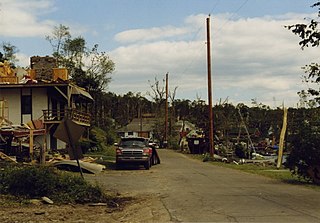
The Tornado outbreak of June 2, 1998, was one of the most significant tornado outbreaks in recent history over the east-central United States. This severe weather event spawned a total of 47 tornadoes over 9 states from New York to South Carolina and caused an estimated $42 million in damage, 80 injuries and 2 fatalities. For Pennsylvania in particular, it was the second historic and deadly severe weather outbreak in three days, as it immediately followed the Late-May 1998 Tornado Outbreak and Derecho on May 30–31, 1998, which spawned 41 tornadoes over New York, New Jersey, Pennsylvania and Vermont, caused an estimated $83 million in damage, 109 injuries and one fatality.
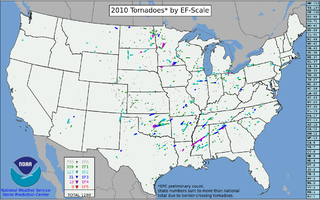
This page documents the tornadoes and tornado outbreaks of 2010. The majority of tornadoes form in the U.S., but they can occur almost anywhere under the right conditions. A lesser number occur outside the U.S., most notably in parts of neighboring southern Canada during the Northern Hemisphere's summer season, but are also known in South America, Europe, Asia, and Australia.

Global storm activity of 2006 profiles the major worldwide storms, including blizzards, ice storms, and other winter events, from January 1, 2006 to December 31, 2006. Winter storms are events in which the dominant varieties of precipitation are forms that only occur at cold temperatures, such as snow or sleet, or a rainstorm where ground temperatures are cold enough to allow ice to form. It may be marked by strong wind, thunder and lightning, heavy precipitation, such as ice, or wind transporting some substance through the atmosphere. Other major non winter events such as large dust storms, Hurricanes, cyclones, tornados, gales, flooding and rainstorms are also caused by such phenomena to a lesser or greater existent.
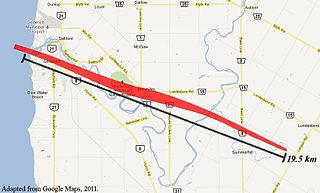
The 2011 Goderich, Ontario tornado was an F3 tornado generated by an isolated supercell which unexpectedly tore across Huron County, Ontario, on the afternoon of Sunday, August 21, 2011. Beginning as a tornadic waterspout over Lake Huron, the tornado ripped through the lakeside town of Goderich severely damaging the historic downtown and homes in the surrounding area. One person died and 37 more were injured as a result. This was the strongest tornado to hit Ontario in over fifteen years, since the April 20, 1996, tornado outbreak in Williamsford, Arthur, and Violet Hill.

The 2018 United States–Canada tornado outbreak was a two-day tornado outbreak that affected the Great Lakes region of the United States on September 20, 2018, and the National Capital Region of Canada on September 21, 2018. 37 tornadoes were confirmed, including a long-tracked EF3 that moved along a 80 km (50 mi) path from near Dunrobin, Ontario to Gatineau, Quebec, and an EF2 in the Nepean sector of Ottawa. The tornadoes in Ottawa-Gatineau were declared one of the ten most significant weather events of 2018 in Canada by the Meteorological Service of Canada.
References
- Rennison, J. (2005, November 10). Blown Away. Hamilton Spectator, p. A7
- https://web.archive.org/web/20060426202608/http://www.ctv.ca/servlet/ArticleNews/story/CTVNews/20051110/hamilton_tornado_claims_051110/20051110?hub=CTVNewsAt11
- https://web.archive.org/web/20080512150515/http://www.ontariostorms.com/2005/index.html